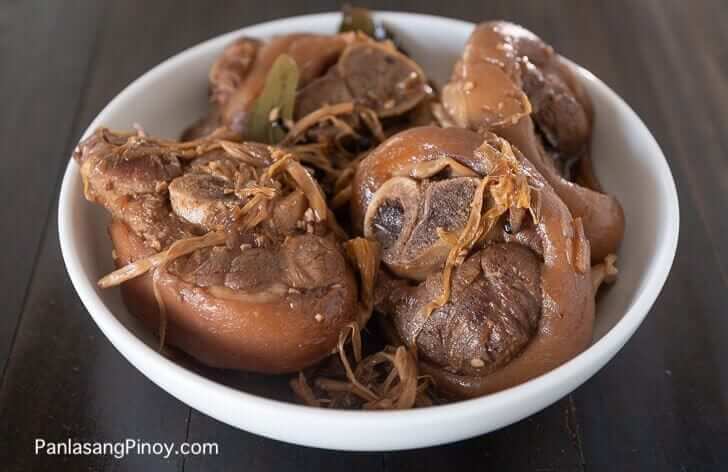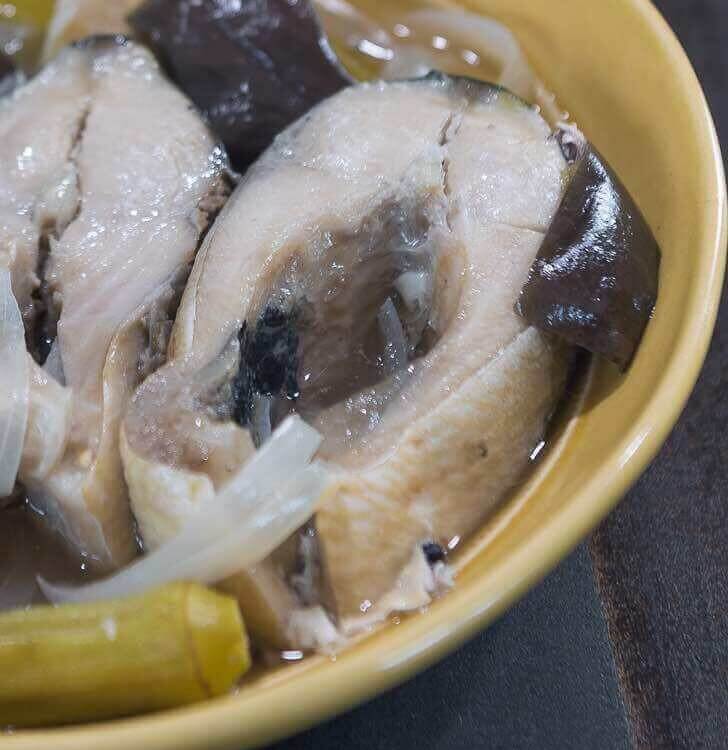Paksiw Na Baboy
Paksiw na baboy is a well-known Filipino dish. Its name comes from two Tagalog words: “paksiw,” which means “cooked in vinegar,” and “baboy,” which means “pork.” This dish usually uses pork belly or ribs, which are cooked slowly in vinegar, soy sauce, garlic, and bay leaves. The slow cooking makes the pork very tender and gives it a tangy, savoy flavor.
This post may contain affiliate links. Please read our disclosure policy.
If you like lechon paksiw and are looking for a similar great tasting dish, try paksiw na baboy! It is comforting and flavorful. Served it with white rice for the best experience.

How to Cook Paksiw na Baboy
- First, sear the pork until it browns. Continue until enough oil gets extracted.
- Introduce the garlic into the mix, sautéing it for precisely one minute to release its aromatic essence. Then gradually pour in the soy sauce and water, allowing the mixture to reach a boiling point.
- Next, add bay leaves and whole peppercorns to the concoction, covering the cooking pot securely. Adjust the heat to a gentle simmer and maintain for 30 minutes.
- Moderate the heat setting, between low and medium, and incorporate the vinegar. Allow the mixture to reach a boiling state, stirring occasionally.
- After that, add banana blossoms into the simmering pot. Adjust the heat to its lowest setting, and allow the ingredients to meld together for an additional 30 minutes.
- Enhance the flavor profile by adding brown sugar and seasoning with Maggi Magic Sarap to taste. Present the paksiw na baboy piping hot.
- Share and savor!

How to Serve Paksiw na Baboy
This dish is best served warm and is traditionally enjoyed with steamed white rice, which helps balance the tangy and savory flavors of the dish. The mild flavor of the rice complements the tangy sauce. Savor this delightful meal, enjoy every bite, and let the comforting flavors of Filipino cuisine wrap you in warmth!
Origins And Purpose Of Paksiw
The origins of paksiw can be traced back to the need of Filipinos for preserving food in the Philippines’ tropical climate, where refrigeration was not always available. Vinegar acts as a natural preservative and a tenderizer. It helps to keep the meat safe to eat for longer periods. This method became popular for cooking various types of meat, including pork, as it adds a distinctive tangy kick and makes the meat tender. Over time, paksiw evolved into a beloved part of Filipinos, with recipes passed down through generations. This cooking style not only preserves food but also enhances its taste, making it a staple in many Filipino households.

Paksiw na Baboy Ingredients
In the Philippines, a dish that’s both sour and tasty is often funnily referred to as “asim-sarap,” with “asim” meaning sour and “sarap” meaning delicious. Check out the ingredient list below and make your own asim-sarap paksiw na baboy!
-
- 2 lbs. pork belly, sliced into cubes — Pork belly is the main ingredient and provides a rich, fatty flavor that becomes tender and flavorful when slow-cooked in the sauce.
-
- 1 head garlic, crushed — Crushing the garlic helps release its essential oils, enhancing the overall taste.
-
- 4 tablespoons soy sauce — Soy sauce adds depth of flavor and a salty, umami taste to the dish. It also contributes to the dark color of the sauce.
-
- 1 cup water — Water helps to create the cooking liquid for the sauce, ensuring the pork is properly simmered and tender.
-
- 6 tablespoons white vinegar — White vinegar provides the characteristic tanginess of paksiw na baboy, helping to tenderize the pork and balance the flavors of this Filipino dish.
-
- ¼ cup brown sugar — Brown sugar adds a touch of sweetness to balance the sourness of the vinegar and enhances the overall taste profile of our paksiw na baboy.
-
- 100 grams banana blossoms — Banana blossoms add a unique texture and mild aroma to the dish. They are usually soaked in water before cooking to soften them.
-
- 3 pieces dried bay leaves — Bay leaves infuse the dish with a subtle, herbal aroma during the cooking process.
-
- 1 tablespoon whole peppercorn — Peppercorns for a spicy kick and added depth of flavor. They are left whole to infuse their flavor without overpowering the dish.
-
- 4 grams Maggi Magic Sarap — A seasoning blend for extra boost of umami and deliciousness
Shelf Life Of Paksiw Na Baboy
How long does paksiw na baboy last? Its shelf life depends on how you store it. If you keep it in the refrigerator, it will last for about 3 to 4 days. To keep it fresh, store it in an airtight container. If you want to keep it for a longer period, you can freeze it, where it will remain good for up to 2 to 3 months.
Proper storage of paksiw na baboy helps ensure that it remains safe to eat and retains its quality. To reheat, it is best to thaw the dish in the refrigerator before warming it up on the stove or in the microwave.

Did you make this? If you snap a photo, please be sure tag us on Instagram at @panlasangpinoy or hashtag #panlasangpinoy so we can see your creations!

Paksiw na Baboy
Ingredients
- 2 lbs. pork belly sliced into cubes
- 1 head garlic crushed
- 4 tablespoons soy sauce
- 1 cup water
- 6 tablespoons white vinegar
- ¼ cup brown sugar
- 100 grams banana blossoms
- 3 pieces dried bay leaves
- 1 tablespoon whole peppercorn
- 4 grams Maggi Magic Sarap
Instructions
- Sear the pork until it browns, and enough oil gets extracted.2 lbs. pork belly
- Add the garlic. Sauté for 1 minute.1 head garlic
- Pour soy sauce and water. Let it boil.4 tablespoons soy sauce, 1 cup water
- Add bay leaves and whole peppercorn. Cover the cooking pot. Adjust to a simmer and continue cooking for 30 minutes.3 pieces dried bay leaves, 1 tablespoon whole peppercorn
- Adjust the heat setting between low and medium. Add vinegar. Let it boil. Stir.6 tablespoons white vinegar
- Add the banana blossoms. Adjust the heat to the lowest setting. Continue to cook for 30 minutes.100 grams banana blossoms
- Add brown sugar and season with Maggi Magic Sarap.¼ cup brown sugar, 4 grams Maggi Magic Sarap
- Serve hot. Share and enjoy!




Leave a Comment